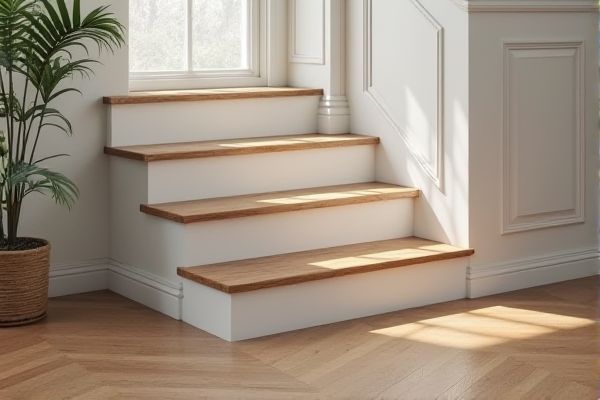
Tread nosing features a rounded or beveled edge that enhances safety by reducing sharp corners and providing better grip, while square edge tread offers a clean, modern look but may wear down more quickly and pose a tripping hazard. Discover which tread option best suits Your staircase needs by exploring the detailed comparison in the rest of this article.
Table of Comparison
| Feature | Tread Nosing | Square Edge Tread |
|---|---|---|
| Definition | Extended edge of the stair tread protruding beyond the riser. | Flush edge where the tread aligns directly with the riser. |
| Safety | Improves grip and reduces slip risk. | Less grip, slightly higher slip risk. |
| Aesthetics | Provides a classic and finished look. | Offers a minimalist and modern appearance. |
| Durability | Protects riser edges from wear and tear. | Higher vulnerability to chipping on edges. |
| Installation | Requires precise measurement for overhang. | Simpler and faster installation process. |
| Common Applications | Residential and commercial staircases needing enhanced safety. | Modern architectural designs emphasizing clean lines. |
Introduction to Tread Nosing and Square Edge Treads
Tread nosing refers to the rounded or beveled edge extending beyond the riser, enhancing safety by providing better grip and reducing slip hazards on stairs. Square edge treads feature a clean, 90-degree edge without overhang, offering a modern and minimalist look that aligns flush with the riser below. Your choice between tread nosing and square edge treads impacts stair durability, aesthetics, and slip resistance, making it essential to consider usage context and safety requirements.
What is Tread Nosing?
Tread nosing refers to the rounded or angled front edge of a stair tread that extends beyond the riser, enhancing safety by providing better grip and increased surface area for foot placement. It reduces the risk of slips and falls while also protecting the stair edge from wear and damage over time. Compared to square edge treads, which have a sharp 90-degree edge, tread nosing offers improved ergonomics and durability in both residential and commercial stair designs.
What is a Square Edge Tread?
A square edge tread is a type of stair tread characterized by its sharp, 90-degree front edge without any rounding or molding. This design offers a clean and modern look, allowing the stair edges to align precisely with the riser below for a streamlined appearance. Square edge treads are commonly used in contemporary architecture where minimalistic aesthetics and ease of installation are prioritized.
Key Design Differences
Tread nosing features a rounded or beveled edge extending beyond the riser, enhancing safety by providing extra grip and reducing trip hazards. Square edge treads have a straight, sharp edge that aligns flush with the riser for a streamlined, modern look but offer less slip resistance. Your choice impacts both aesthetic appeal and functional performance in stair design.
Safety and Slip Resistance Comparison
Tread nosing provides enhanced safety by extending the edge of each step, reducing the risk of slips and falls through increased surface area and improved foot grip. Square edge treads, lacking this protrusion, may pose a higher slip hazard, especially in high-traffic or wet environments. Your choice of tread design directly impacts slip resistance and overall stair safety, making tread nosing a preferred option for minimizing accidents.
Aesthetic Impact on Staircases
Tread nosing creates a rounded edge that enhances the visual flow and adds a subtle softness to staircases, making them appear more refined and inviting. Square edge treads offer a sharp, clean finish that works well with modern and minimalist designs, emphasizing geometric precision and simplicity. The choice between nosing and square edges significantly influences the staircase's overall aesthetic, balancing between traditional warmth and contemporary sleekness.
Installation and Maintenance Considerations
Tread nosing offers easier installation due to its pre-formed edge that fits securely over stair edges, reducing the risk of gaps and improving safety. Square edge tread requires precise cutting and alignment to ensure a flush fit, demanding more meticulous installation and adjustment. Your choice impacts long-term maintenance, as tread nosing typically provides enhanced durability and simpler cleaning compared to the flat, exposed edges of square tread.
Cost Comparison
Tread nosing typically incurs higher costs than square edge treads due to the added material and labor required for shaping and installation. Square edge treads offer a more budget-friendly option, as they involve simpler manufacturing and less precise fitting. When balancing durability and aesthetics, tread nosing may justify the cost for high-traffic areas, while square edge treads suit projects with strict budget constraints.
Best Use Cases for Each Option
Tread nosing provides enhanced safety and traction, making it ideal for high-traffic areas where slip resistance is crucial, such as commercial staircases and public buildings. Square edge treads offer a clean, modern aesthetic suited for residential settings or architectural designs emphasizing minimalism and sharp lines. Your choice depends on balancing safety requirements with design preferences to ensure optimal functionality and style.
Choosing the Right Tread for Your Project
Selecting the appropriate tread for your project involves comparing tread nosing and square edge tread, each offering distinct benefits. Tread nosing enhances safety by providing extra grip and visibility on stair edges, ideal for high-traffic areas or commercial settings. Square edge treads provide a clean, modern look and are easier to install, making them suitable for minimalist designs or residential projects where aesthetics and simplicity are priorities.
 homyna.com
homyna.com